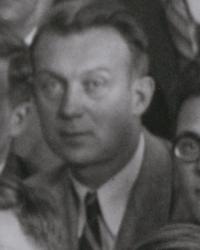Related Research Articles

Otto Hahn was a German chemist who was a pioneer in the fields of radioactivity and radiochemistry. He is referred to as the father of nuclear chemistry and father of nuclear fission. Hahn and Lise Meitner discovered radioactive isotopes of radium, thorium, protactinium and uranium. He also discovered the phenomena of atomic recoil and nuclear isomerism, and pioneered rubidium–strontium dating. In 1938, Hahn, Lise Meitner and Fritz Strassmann discovered nuclear fission, for which Hahn received the 1944 Nobel Prize for Chemistry. Nuclear fission was the basis for nuclear reactors and nuclear weapons.

Walther Wilhelm Georg Bothe was a German nuclear physicist know for the development of coincidence methods to study particle physics.

Max Theodor Felix von Laue was a German physicist who received the Nobel Prize in Physics in 1914 for his discovery of the diffraction of X-rays by crystals.
Ernst J. L. Gehrcke was a German experimental physicist. He was director of the optical department at the Reich Physical and Technical Institute. Concurrently, he was a professor at the University of Berlin. He developed the Lummer–Gehrcke method in interferometry and the multiplex interferometric spectroscope for precision resolution of spectral-line structures. As an anti-relativist, he was a speaker at an event organized in 1920 by the Working Society of German Scientists. He sat on the board of trustees of the Potsdam Astrophysical Observatory. After World War II, he worked at Carl Zeiss Jena, and he helped to develop and become the director of the Institute for Physiological Optics at the University of Jena. In 1949, he began work at the German Office for Materials and Product Testing. In 1953, he became the director of the optical department of the German Office for Weights and Measures.

The German Physical Society is the oldest organisation of physicists. The DPG's worldwide membership is cited as 52,220, as of 2022, making it one of the largest national physics societies in the world. The number of the DPG's members peaked in 2014, when it reached 63,000, but it has been decreasing since then. It holds an annual conference and multiple spring conferences, which are held at various locations and along topical subjects of given sections of the DPG. The DPG serves the fields of pure and applied physics. Main aims are to bring its members and all physicists living in Germany closer together, represent their entirety outwards as well as foster the exchange of ideas between its members and foreign colleagues. The DPG binds itself and its members to advocate for freedom, tolerance, veracity and dignity in science and to be aware about the fact that the people working in science are responsible to a particularly high extent for the configuration of the overall human activity.

The Gottfried Wilhelm Leibniz Prize, or Leibniz Prize, is awarded by the German Research Foundation to "exceptional scientists and academics for their outstanding achievements in the field of research". Since 1986, up to ten prizes have been awarded annually to individuals or research groups working at a research institution in Germany or at a German research institution abroad. It is considered the most important research award in Germany.

The Berlin-Brandenburg capital region is one of the most prolific centers of higher education and research in the world. It is the largest concentration of universities and colleges in Germany. The city has four public research universities and 27 private, professional and technical colleges (Hochschulen), offering a wide range of disciplines. Access to the German university system is tuition free.
The Berlin Graduate School of Natural Sciences and Engineering (BIG-NSE) is part of the Cluster of Excellence "Unifying Concepts in Catalysis" (UniCat) founded in November 2007 by the Technical University of Berlin and five further institutions in the Berlin area within the framework of the German government‘s Excellence Initiative.
Siegfried Flügge was a German theoretical physicist who made contributions to nuclear physics and the theoretical basis for nuclear weapons. He worked on the German nuclear energy project. From 1941 onward he was a lecturer at several German universities, and from 1956 to 1984, editor of the 54-volume, prestigious Handbuch der Physik.

Otto Haxel was a German nuclear physicist. During World War II, he worked on the German nuclear energy project. After the war, he was on the staff of the Max Planck Institute for Physics in Göttingen. From 1950 to 1974, he was an ordinarius professor of physics at the University of Heidelberg, where he fostered the use of nuclear physics in environmental physics; this led to the founding of the Institute of Environmental Physics in 1975. During 1956 and 1957, he was a member of the Nuclear Physics Working Group of the German Atomic Energy Commission. From 1970 to 1975, he was the Scientific and Technical Managing Director of the Karlsruhe Research Center.
Wolfgang Gentner was a German experimental nuclear physicist.
Georg Carl Stetter was an Austrian-German nuclear physicist. Stetter was Director of the Second Physics Institute of the University of Vienna. He was a principal member of the German nuclear energy project, also known as the Uranium Club. In the latter years of World War II, he was also the Director of the Institute for Neutron Research. After the war, he was dismissed from his university positions, and he then became involved in dust protection research. After his dismissal was overturned, he became Director of the First Physics Institute of the University of Vienna, and he began research on aerosols. In 1962, Stetter became a full Member of the Austrian Academy of Sciences. In that same year, the Academy established their Commission for Clean Air, and Stetter served as its chairman until 1985.

Wilhelm Hanle was a German experimental physicist. He is known for the Hanle effect. During World War II, he made contributions to the German nuclear energy project, also known as the Uranium Club. From 1941 until emeritus status in 1969, he was an ordinarius professor of experimental physics and held the chair of physics at the University of Giessen.

Hans Kopfermann was a German atomic and nuclear physicist. He devoted his entire career to spectroscopic investigations, and he did pioneering work in measuring nuclear spin. During World War II, he worked on the German nuclear energy project, also known as the Uranium Club.
Scheel is a surname of Germanic origin. Notable people with the surname include:
Gottfried Freiherr von Droste (1908–1992), a.k.a. Gottfried Freiherr von Droste zu Vischering-Padberg, was a German physical chemist. He worked at the Kaiser Wilhelm Institute for Chemistry (KWIC). He independently predicted that nuclear fission would release a large amount of energy. During World War II, he participated in the German nuclear energy project, also known as the Uranverein. In the latter years of the war, he worked at the Reich's University of Strassburg. After the war, he worked at the Physikalisch-Technische Bundesanstalt (Federal Physical and Technical Institute and also held a position at the Technical University of Braunschweig.

Karl Friedrich Franz Christian Scheel was a German physicist. He was a senior executive officer and head of Department IIIb at the Reich Physical and Technical Institute. Additionally, he served as editor of the journal Fortschritte der Physik, the semi-monthly bibliographic section of the journal Physikalische Berichte, the Verhandlungen of the German Physical Society, and the society’s journal Zeitschrift für Physik. From 1926 to 1935, he was editor of the Handbuch der Physik. An endowment by Scheel and his wife Melida funds the annual awarding of the Karl Scheel Prize by the Physical Society in Berlin.

Helmholtz-Zentrum Berlin für Materialien und Energie is part of the Helmholtz Association of German Research Centres. The institute studies the structure and dynamics of materials and investigates solar cell technology. It also runs the third-generation BESSY II synchrotron in Adlershof. Until the end of 2019 it ran the 10 megawatt BER II nuclear research reactor at the Lise Meitner campus in Wannsee.

The Cluster of Excellence Unifying Systems in Catalysis (UniSysCat) is an interdisciplinary research network funded by the German Research Foundation (DFG) as a part of the federal and state excellence strategy of Germany, Exzellenzstrategie. The funding period runs from January 1, 2019 to December 31, 2025. Around 300 researchers from the Berlin and Potsdam areas work at UniSysCat, focusing on current issues in catalysis research. UniSysCat is the follow-up project of the Cluster of Excellence Unifying Concepts in Catalysis (UniCat), which was funded from 2007 to 2018 as part of the federal and state excellence initiative of Germany Exzellenzstrategie.
Ulrike I. Kramm is a German chemistry professor at Technische Universität Darmstadt. Her research considers the development and characterisation of metal catalysts for fuel cells, CO2 conversion and solar fuels.
References
- ↑ "Physical Society of Berlin honors Ricarda Winkelmann — Potsdam Institute for Climate Impact Research". www.pik-potsdam.de. Retrieved 2022-04-07.
- ↑ Karl-Scheel-Preis der Physikalischen Gesellschaft zu Berlin – Karl Scheel Prize at the German Physical Society official website
- ↑ "Archiv der Träger des KSP". www.pgzb.tu-berlin.de. Retrieved 2020-06-17.